Rare Earth Element Deposits in Mongolia
Abstract
:1. Introduction
2. Geologic Background
3. Rare Earth Element Deposits
3.1. Carbonatite-Associated Deposits
3.2. Peralkaline Rock-Associated Deposits
4. Mongolian REE Deposits
4.1. Carbonatite Deposits
4.1.1. Mushgai Khudag
4.1.2. Khotgor
4.1.3. Lugiin Gol
4.1.4. Bayan Khoshuu and Ulgii Khiid
4.2. Peralkaline Granitic Deposits
4.2.1. Khalzan-Buregtei
4.2.2. Ulaan Tolgoi
4.2.3. Khanbogd
5. Conclusions
Author Contributions
Funding
Data Availability Statement
Acknowledgments
Conflicts of Interest
References
- Badarch, G.; Cunningham, W.D.; Windley, B.F. A new terrane subdivision for Mongolia: Implications for the Phanerozoic crustal growth of Central Asia. J. Asian Earth Sci. 2002, 21, 87–110. [Google Scholar] [CrossRef]
- Şengör, A.M.C.; Natalin, B.A.; Burtman, V.S. Evolution of the Altaid tectonic collage and Palaeozoic crustal growth in Eurasia. Nature 1993, 364, 299–307. [Google Scholar] [CrossRef]
- Kovalenko, V.I.; Yarmolyuk, V.V. Endogenous rare metal ore formations and rare metal metallogeny of Mongolia. Econ. Geol. 1995, 90, 520–529. [Google Scholar] [CrossRef]
- Verplanck, P.L.; Van Gosen, B.S.; Seal, R.R.; McCafferty, A.E. A deposit model for carbonatite and peralkaline intrusion-related rare earth element deposits. In U.S. Geological Survey Scientific Investigations Report 2010–5070-J; U.S. Geological Survey: Reston, VA, USA, 2014; 58p. [Google Scholar] [CrossRef] [Green Version]
- Huleatt, M.B. Australian Resource Reviews: Rare Earth Elements; Geoscience Australia: Canberra, Australia, 2019; ISBN 978-1-925848-44-1. [Google Scholar]
- Vladykin, N.V.; Kovalenko, V.I.; Kashaev, A.A.; Sapozhnikov, A.N.; Pisarskaya, V.A. Armstrongite—A new silicate of calcium and zirconium. Doklady Acad. Nauk. SSSR 1973, 20, 1185–1188. (In Russian) [Google Scholar]
- Le Maitre, R.W.; Streckeisen, A.; Zanettin, B.; Le Bas, M.J.; Bonin, B.; Bateman, P.; Woollet, A.R. Igneous Rocks. A Classification of Igneous Rocks and Glossary of Terms, 2nd ed.; Cambridge University Press: Cambridge, NY, USA, 2002; 236p. [Google Scholar]
- Yaxley, G.M.; Anenburg, M.; Tappe, S.; Decree, S.; Guzmics, T. Carbonatites: Classification, Sources, Evolution, and Emplacement. Annu. Rev. Earth Planet. Sci. 2022, 50, 261–293. [Google Scholar] [CrossRef]
- Kamenetsky, V.S.; Doroshevich, A.G.; Elliott, H.A.L.; Zaitsev, A.N. Carbonatites: Contrasting, complex, and controversial. Elements 2021, 17, 307–314. [Google Scholar] [CrossRef]
- Woolley, A.R.; Kjarsgaard, B.A. Paragenetic types of carbonatite as indicated by the diversity and relative abundances of associated silicate rocks: Evidence from a global database. Can. Mineral. 2008, 46, 741–752. [Google Scholar] [CrossRef]
- Bell, K. Carbonatites: Genesis and Evolution; Unwin Hyman: London, UK, 1989; 618p. [Google Scholar]
- Mitchell, R.H. Carbonatites and carbonatites and carbonatites. Can. Mineral. 2005, 43, 2049–2068. [Google Scholar] [CrossRef]
- Woolley, A.R.; Church, A.A. Extrusive carbonatites: A brief review. Lithos 2005, 85, 1–14. [Google Scholar] [CrossRef]
- Chakhmouradian, A.R.; Zaitsev, A.N. 2012 Rare earth mineralization in igneous rocks: Sources and processes. Elements 2012, 8, 347–353. [Google Scholar] [CrossRef]
- Verplanck, P.L.; Mariano, A.N.; Mariano, A.N., Jr. Rare earth element ore geology of carbonatites. In Reviews in Economic Geology; Verplanck, P.L., Hitzman, M.W., Eds.; Society of Economic Geologists, Inc.: Littleton, CO, USA, 2016; Volume 18, pp. 5–32. [Google Scholar]
- Richardson, D.G.; Birkett, T.C. Carbonatite-associated deposits. In Geology of North America; Geological Society of America: Boulder, CO, USA, 1996; Volume P-1, pp. 541–558. [Google Scholar]
- Long, K.R.; Van Gosen, B.S.; Foley, N.K.; Cordier, D. The Principal Rare Earth Elements Deposits of the United States—A Summary of Domestic Deposits and A Global Perspective; U.S. Geological Survey, Scientific Investigations Report 2010–5220; U.S. Geological Survey: Reston, VA, USA, 2010; 96p. [Google Scholar]
- Castor, S.B. The Mountain Pass rare-earth carbonatite and associated ultrapotassic rocks, California. Can. Mineral. 2008, 46, 779–806. [Google Scholar] [CrossRef] [Green Version]
- Salvi, S.; Williams-Jones, A.E. The role of hydrothermal processes in the granite-hosted Zr, Y, REE deposit at Strange Lake, Quebec/Labrador: Evidence from fluid inclusions. Geochim. Cosmochim. Acta 1990, 54, 2403–2418. [Google Scholar] [CrossRef]
- Salvi, S.; Williams-Jones, A.E. The role of hydrothermal processes in concentrating high-feld strength elements in the Strange Lake peralkaline complex, northeastern Canada. Geochim. Cosmochim. Acta 1996, 60, 1917–1932. [Google Scholar] [CrossRef]
- Dostal, J.; Kontak, D.J.; Karl, S.M. The Early Jurassic Bokan Mountain peralkaline granitic complex (southeastern Alaska): Geochemistry, petrogenesis and rare-metal mineralization. Lithos 2014, 202–203, 395–412. [Google Scholar] [CrossRef]
- Ersay, L.; Greenough, J.D.; Larson, K.P.; Dostal, J. Zircon reveals multistage, magmatic and hydrothermal Rare earth mineralization at the Debert Lake, Nova Scotia, Canada. Ore Geol. Rev. 2022, 144, 104780. [Google Scholar] [CrossRef]
- Bernard, C.; Estrade, G.; Salvi, S.; Beziat, D.; Smith, M. Alkali pyroxenes and amphiboles: A window on rare earth elements and other high field strength elements behaviour through the magmatic-hydrothermal transition of peralkaline granitic systems. Contrib. Mineral. Petrol. 2020, 175, 81. [Google Scholar] [CrossRef]
- Siegel, K.; Williams-Jones, A.E.; van Hinsberg, V.J. The amphiboles of the REE-rich A-type peralkaline Strange Lake pluton fingerprints of magma evolution. Lithos 2017, 288–289, 156–174. [Google Scholar] [CrossRef] [Green Version]
- Vasyukova, O.V.; Williams-Jones, A.E. Tracing the evolution of a fertile REE granite by modelling amphibole-melt partitioning: The Strange Lake story. Chem. Geol. 2019, 519, 79–89. [Google Scholar] [CrossRef]
- Dostal, J. Rare Earth Element Deposits of Alkaline Igneous Rocks. Resources 2017, 6, 98–109. [Google Scholar] [CrossRef] [Green Version]
- Boynton, W.V. Cosmochemistry of the rare earth elements; meteorite studies. In Rare Earth Element Geochemistry; Henderson, P., Ed.; Elsevier: Amsterdam, The Netherlands, 1984; pp. 63–114. [Google Scholar]
- Vladykin, N.V. Petrology and composition of rare-metal alkaline rocks in the South Gobi Desert, Mongolia. Russ. Geol. Geophys. 2013, 54, 416–435. [Google Scholar] [CrossRef]
- Samoilov, V.S.; Kovalenko, V.I. Complexes of Alkaline Rocks and Carbonatites in South Mongolia; Nauka: Moscow, Russia, 1983; 196p. (In Russian) [Google Scholar]
- Baatar, M.; Ochir, G.; Kynicky, J.; Iizumi, S.; Comin-Chiaramonti, P. Some notes on the Lugiin Gol, Mushgai Khudag and Bayan Khoshuu Alkaline Complexes, Southern Mongolia. Int. J. Geosci. 2013, 4, 1200–1214. [Google Scholar] [CrossRef] [Green Version]
- Nikolenko, A.M.; Doroshkevich, A.G.; Ponomarchuk, A.V.; Redina, A.A.; Prokorpyev, I.R.; Vladykin, N.V.; Nikolaeva, I.V. Ar-Ar geochronology and petrogenesis of Mushgai-Khudag alkaline-carbonatite complex (southern Mongolia). Lithos 2020, 372, 15675. [Google Scholar] [CrossRef]
- Nikiforov, A.V.; Yarmolyuk, V.V. Late Mesozoic carbonatite provinces in Central Asia: Their compositions, sources and genetic settings. Gondwana Res. 2019, 69, 56–72. [Google Scholar] [CrossRef]
- Yarmolyuk, V.V.; Nikiforov, A.V.; Salnikova, E.B. Rare-metal granitoids of the Ulug Tanzek Deposit (Eastern Tyva): Age and tectonic setting. Dokl. Earth Sci. 2010, 430, 95–100. [Google Scholar] [CrossRef]
- Yarmolyuk, V.V.; Kuzmin, M.I. Late Paleozoic and Early Mesozoic rare-metal magmatism of Central Asia: Stages, provinces, and formation settings. Geol. Ore Depos. 2012, 54, 313–333. [Google Scholar] [CrossRef] [Green Version]
- Yarmolyuk, V.V.; Lykhin, D.A.; Kozlovskii, A.M. Composition, sources, and mechanisms of origin of rare metal granitoids in the Late Paleozoic Eastern Sayan Zone of alkaline magmatism: A case study of the Ulaan Tolgoi Massif. Petrology 2016, 24, 447–496. [Google Scholar] [CrossRef]
- Gerel, O.; Majigsuren, Y.; Munkhtsengel, B. Rare Earth Mineral Deposits. In Mineral Resources of Mongolia; Gerel, O., Pirajno, F., Batkhishig, B., Dostal, J., Eds.; Modern Approaches in Solid Earth Sciences; Springer: Singapore, 2021; pp. 185–210. [Google Scholar]
- Nikolenko, A.M.; Redina, A.A.; Doroshkevich, A.G.; Prokopyev, I.R.; Ragozin, A.L.; Vladykin, N.V. The origin of magnetite-apatite rocks of Mushgai-Khudag complex, South Mongolia: Mineral chemistry and studies of melt and fluid inclusions. Lithos 2018, 320–321, 567–582. [Google Scholar] [CrossRef]
- Gerel, O.; Munkhtsengel, B.; Enkhtuvshin, H.; Iizumi, S. Mushgai Khudag and Bayan Khushuu volcanic-plutonic alkaline complexes with REE Ta, Nb, Fe carbonatite mineralization. In Geodynamics and Metallogeny of Mongolia with Special Emphasis on Copper and Gold Deposits; Seltmann, R., Gerel, O., Kirwin, D., Eds.; IAGOD, Guidebook Series, v. 11; CERCAMS/NHM: London, UK, 2005; pp. 215–221. [Google Scholar]
- Vladykin, N.V. Sr and Nd isotope geochemistry of Siberian and Mongolian alkaline and carbonatite complexes and some geodynamic implications. In Problems of Sources of Deep-Seated Magmatism and Plumes; Glazkovskaya Printing House: Irkutsk, Russia, 2005; pp. 13–29. (In Russian) [Google Scholar]
- McDonough, W.F.; Sun, S.-S. The composition of the Earth. Chem. Geol. 1995, 120, 229–253. [Google Scholar] [CrossRef]
- Elsner, H.; Buchholz, P.; Schmitz, M.; Altangerel, T. Industrial minerals and selected rare metals in Mongolia. In An Investor’s Guide; Mineral Resources Authority of Mongolia, Bundesanstalt für Geowissenschaften und Rohstoffe: Ulaan Baatar, Mongolia; 322p.
- Muff, R.; Tamiraa, A. Rare Earths of Mongolia: Evaluation of Market Opportunities for the Principal Deposits of Mongolia; Technical Report; Mineral Resources Authority of Mongolia, Ulaanbaatar/Bundesanstalt für Geowissenschaften und Rohstoffe: Hannover, Germany, 2013; 63p. [Google Scholar]
- Munkhtsengel, B.; Iizumi, S. Petrology and geochemistryof the Lugiin Gol nepheline syenite complex, southern Mongolia. In Geodynamics and Metallogeny of Mongolia with a Special Emphasis on Copper and Gold Deposits; Seltmann, R., Gerel, O., Kirwin, D., Eds.; IAGOD, Guidebook Series, v. 11; CERCAMS/NHM: London, UK, 2005; pp. 203–214. [Google Scholar]
- Feng, M.; Song, W.; Kynicky, J.; Feng, B.; Fang, G. Geochronology and C-O-Sr-Nd isotopic study of the Ulgii Khiid carbonatite from the Southern Mongolian alkaline province and its implications for the mantle sources. Ore Geol. Rev. 2021, 139, 104495. [Google Scholar] [CrossRef]
- Feng, M.; Song, W.; Kynicky, J.; Smith, M.; Cox, C.; Kotlanova, M.; Brtnicky, M.; Fu, W.; Wei, C. Primary rare earth element enrichment in carbonatites: Evidence from melt inclusions in Ulgii Khiid carbonatite, Mongolia. Ore Geol. Rev. 2020, 117, 103294. [Google Scholar] [CrossRef]
- Kovalenko, V.I.; Tsaryeva, G.M.; Goreglyad, A.V.; Yarmolyuk, V.V.; Troitsky, V.A.; Hervig, R.L.; Farmer, G.L. The peralkaline granite-related Khalzan–Buregtey rare metal (Zr, Nb, REE) deposit, western Mongolia. Econ. Geol. 1995, 90, 530–547. [Google Scholar] [CrossRef]
- Kovalenko, V.I.; Kozlovski, A.M.; Yarmolyuk, V.V. Trace element ratios as indicators of source mixing and magma differentiation of alkali granitoids and basites of the Khalzan-Buregtey massif and the Khalzan-Buregtey rare-metal deposit, western Mongolia. Petrology 2009, 17, 158–177. [Google Scholar] [CrossRef]
- Kovalenko, V.I.; Yarmolyuk, V.V.; Kovach, V.P.; Kovalenko, D.V.; Kozlovskii, A.M.; Andreeva, I.A.; Kotov, A.B.; Salnikova, F.B. Variations in the Nd isotopic ratios and conical ratios of concentrations of incompatible elements as an indication of mixing sources of alkali granitoids and basites in the Khalzan-Buregtei massif and the Khalzan-Buregtei rare metal deposit in Western Mongolia. Petrology 2009, 17, 227–252. [Google Scholar]
- Gronen, L.H.; Sindern, S.; Katzmarzyk, J.L.; Bormann, U.; Hallmann, A.; Wotruba, H.; Meyer, F.M. Mineralogical and Chemical Characterization of Zr-REE-Nb Ores from Khalzan Buregtei (Mongolia)—Approaches to More Efficient Extraction of Rare Metals from Alkaline Granitoids. Minerals 2019, 9, 217. [Google Scholar] [CrossRef] [Green Version]
- Kempe, U.; Götze, J.; Dandar, S.; Habermann, D. Magmatic and metasomatic processes during formation of the Nb–Zr–REE deposits Khalzan Buregtei and Tsakhir (Mongolian Altai): Indications from a combined CL-SEM study. Mineral. Mag. 1999, 63, 165–177. [Google Scholar] [CrossRef]
- Kempe, U.; Möckel, R.; Graupner, T.; Kynicky, J.; Dombon, E. The genesis of Zr-Nb-REE mineralisation at Khalzan Buregtey (Western Mongolia) reconsidered. Ore Geol. Rev. 2015, 64, 602–625. [Google Scholar] [CrossRef]
- Andreeva, I.A. Genesis and mechanisms of formation of rare-metal peralkaline granites of the Khalzan Buregtey massif, Mongolia: Evidence from melt inclusions. Petrology 2016, 24, 462–476. [Google Scholar] [CrossRef]
- Sarangua, N.; Watanabe, Y.; Echigo, T.; Hoshino, M. Chemical Characteristics of Zircon from Khaldzan Buregtei Peralkaline Complex, Western Mongolia. Minerals 2019, 9, 10. [Google Scholar] [CrossRef] [Green Version]
- Lykhin, D.A.; Yarmolyuk, V.V.; Nikiforov, A.V.; Kozlovsky, A.M.; Magazina, L.O. Ulaan-Tolgoi Ta-Nb deposit: The role of magmatism in the formation of rare metal mineralization. Geol. Ore Depos. 2018, 60, 461–485. [Google Scholar] [CrossRef]
- Kynicky, J.; Chakhmouradian, A.R.; Xu, C.; Krmicek, L.; Galiova, M. Distribution and evolution of zirconium mineralization in peralkaline granites and associated pegmatites of the Khanbogd complex, southern Mongolia. Can. Mineral. 2011, 49, 947–965. [Google Scholar] [CrossRef] [Green Version]
- Kovalenko, V.I.; Yarmoluyk, V.V.; Salnikova, E.B.; Kozlovsky, A.M.; Kotov, A.B.; Kovach, V.P.; Savatenkov, V.M.; Vladykin, N.V.; Ponomarchuk, V.A. Geology, geochronology, and geodynamics of the Khanbogd alkali granite pluton in southern Mongolia. Geotectonics 2006, 40, 450–466. [Google Scholar] [CrossRef]
- Amara-Amgalan, S. Petrographical and Geochemical Studies on the Khanbogd Alkaline Complex in Southern Mongolia. Master’s Thesis, Shimane University, Matsue, Japan, 2004. [Google Scholar]
- Mariano, A.N. Economic Geology of Rare Earth Minerals. In Geochemistry and Mineralogy of the Rare Earth Elements; Lipin, B.R., McKay, G.A., Eds.; Mineralogical Society of America: Washington, DC, USA, 1989; Volume 21, pp. 309–337. [Google Scholar]
- Beland, C.M.J.; Williams-Jones, A.E. The mineralogical distribution of the REE in carbonatites: A quantitative evaluation. Chem. Geol. 2021, 585, 120558. [Google Scholar] [CrossRef]
- Beland, C.M.J.; Williams-Jones, A.E. The genesis of the Ashram REE deposit, Quebec: Insights from bulk-rock geochemistry, apatite-monazite-bastnäsite replacement reactions and mineral chemistry. Chem. Geol. 2021, 578, 120298. [Google Scholar] [CrossRef]
- Simandl, G.J.; Paradis, S. Carbonatites: Related ore deposits, resources, footprint, and exploration methods. Appl. Earth Sci. 2018, 127, 123–152. [Google Scholar] [CrossRef] [Green Version]
- Bonin, B. A-type granites and related rocks: Evolution of a concept, problems and prospects. Lithos 2007, 97, 1–29. [Google Scholar] [CrossRef]
- Marks, M.A.; Markl, G. A global review on agpaitic rocks. Earth-Sci Rev. 2017, 173, 229–258. [Google Scholar] [CrossRef]
- Dostal, J. Rare metal deposits associated with alkaline/peralkaline igneous rocks. In Reviews in Economic Geology; Verplanck, P.L., Hitzman, M.W., Eds.; Society of Economic Geologists, Inc.: Littleton, CO, USA, 2016; Volume 18, pp. 33–54. [Google Scholar]
- Salvi, S.; Williams-Jones, A.E. Alkaline granite-syenite deposits. In Geological Association of Canada Short Course Notes; Geological Association of Canada: St. John’s, NF, Canada, 2005; Volume 17, pp. 315–341. [Google Scholar]
- Kovalenko, V.I.; Yarmolyuk, V.V.; Kozlovsky, A.M.; Kovach, V.P.; Salnikova, F.B.; Kotov, A.B.; Vladykin, N.V. Two types of magma sources of rare-metal alkali granites. Geol. Ore Depos. 2007, 49, 442–466. [Google Scholar] [CrossRef]
- Estrade, G.; Salvi, S.; Beziat, D.; Rakotovao, S.; Rakotondrazafy, R. HFSE mineralization in peralkaline granites of the Ambohimirahavavy alkaline complex, Ampasindava peninsula, Madagascar. J. Afr. Earth Sci. 2014, 94, 141–155. [Google Scholar] [CrossRef]
- Salvi, S.; Fontan, F.; Monchoux, P.; Williams-Jones, A.E.; Moine, B. Hydrothermal mobilization of HFSE in alkaline igneous systems: Evidence from the Tamazeght complex (Morocco). Econ. Geol. 2000, 95, 559–576. [Google Scholar]

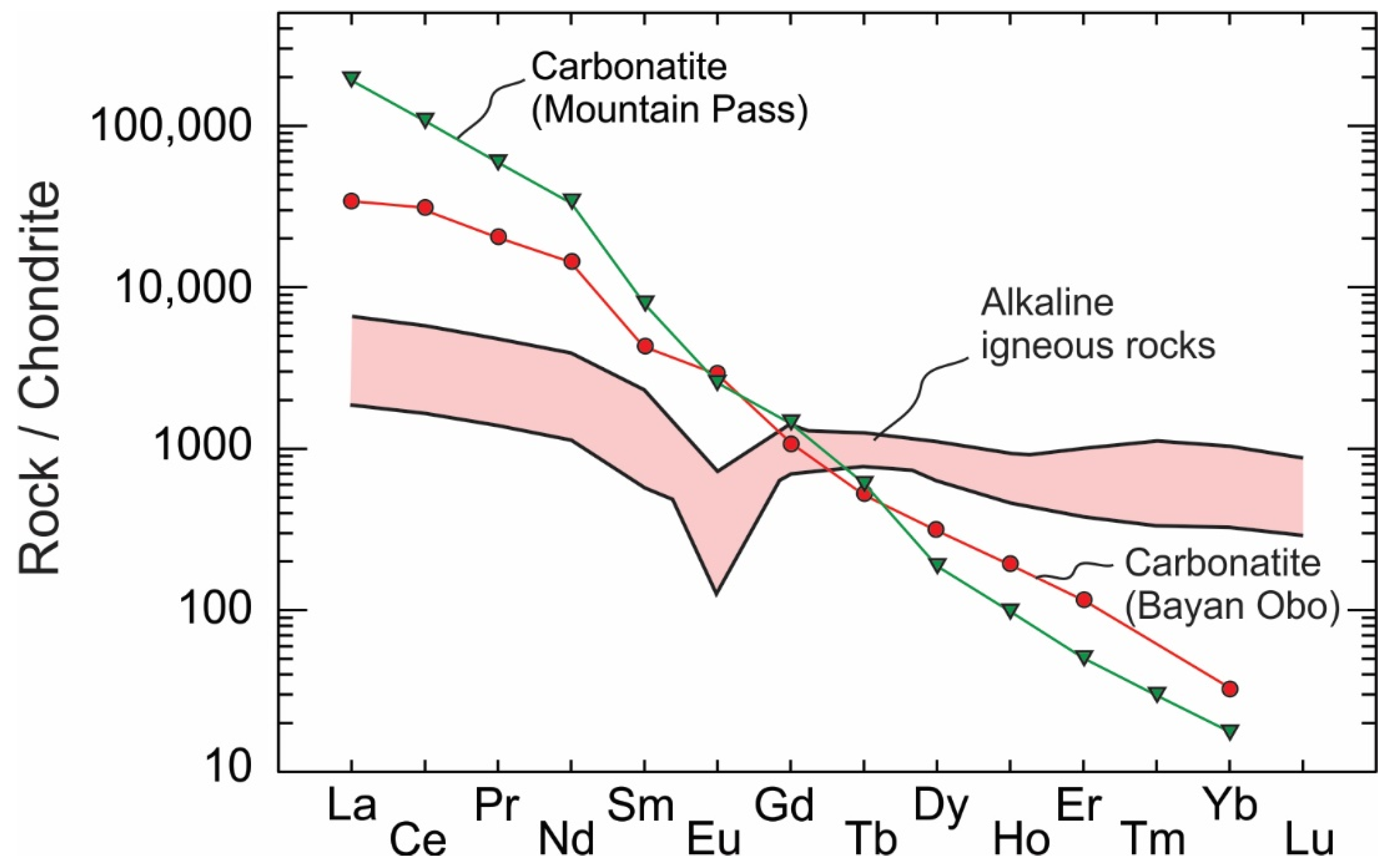


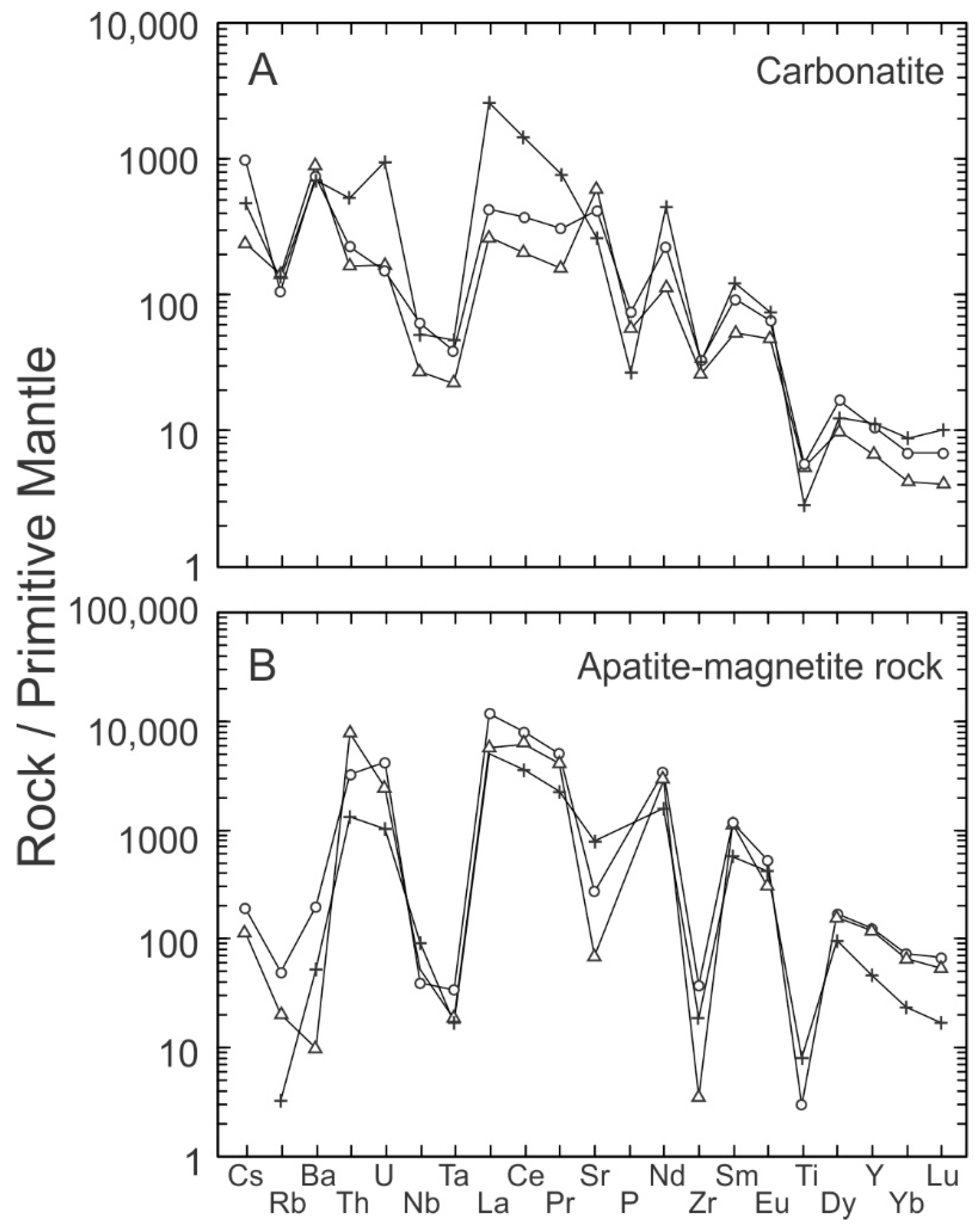
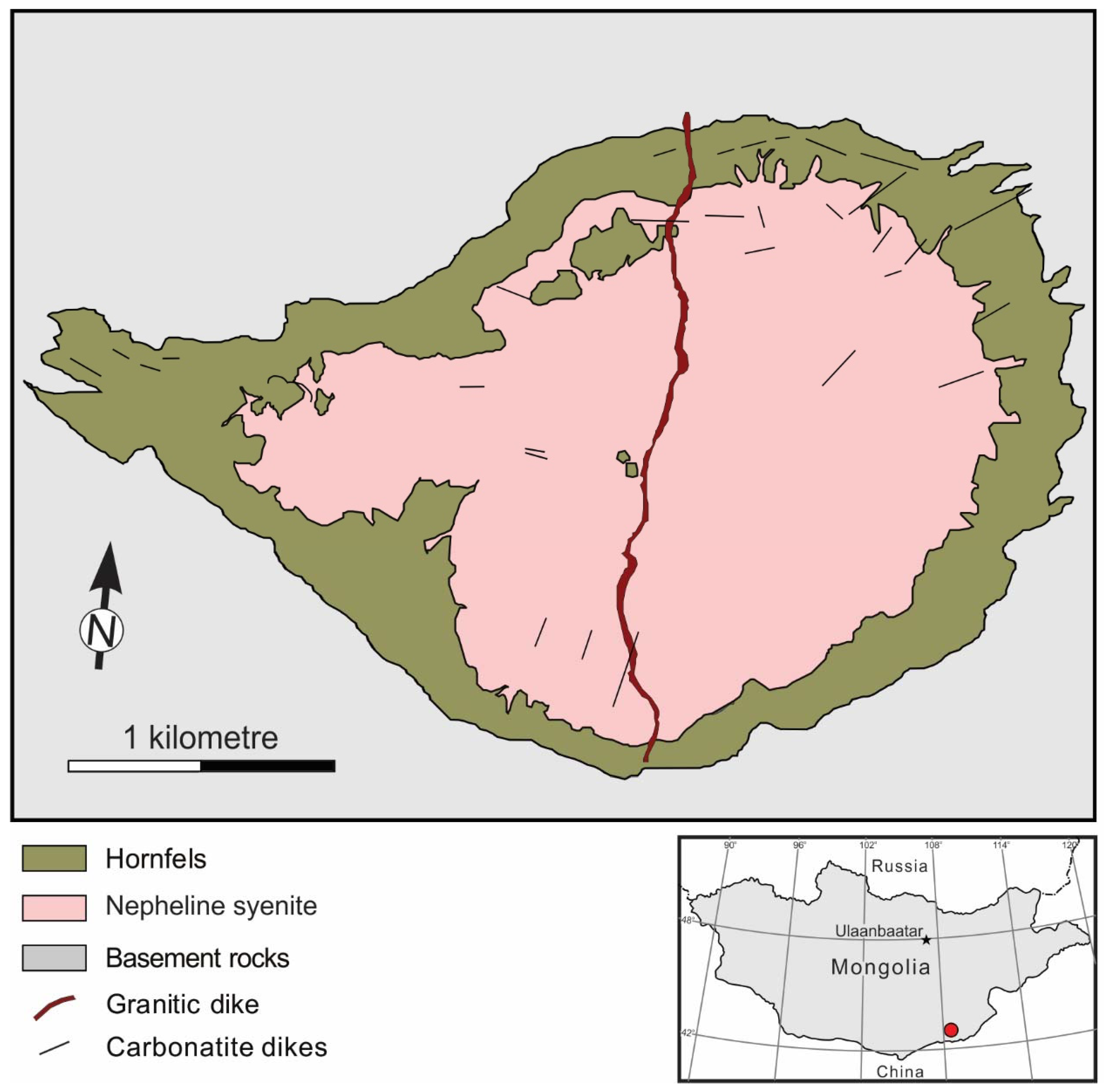
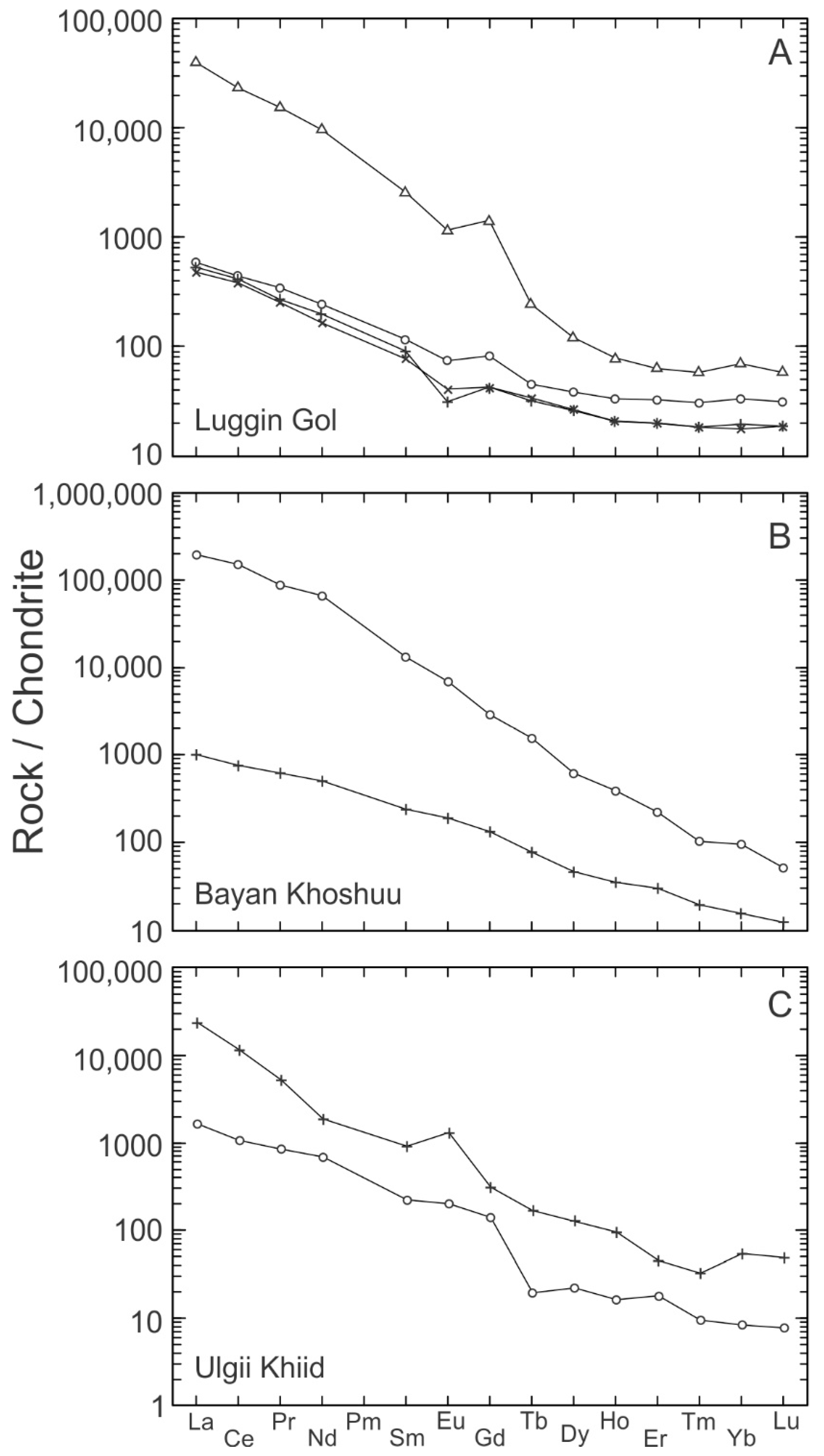
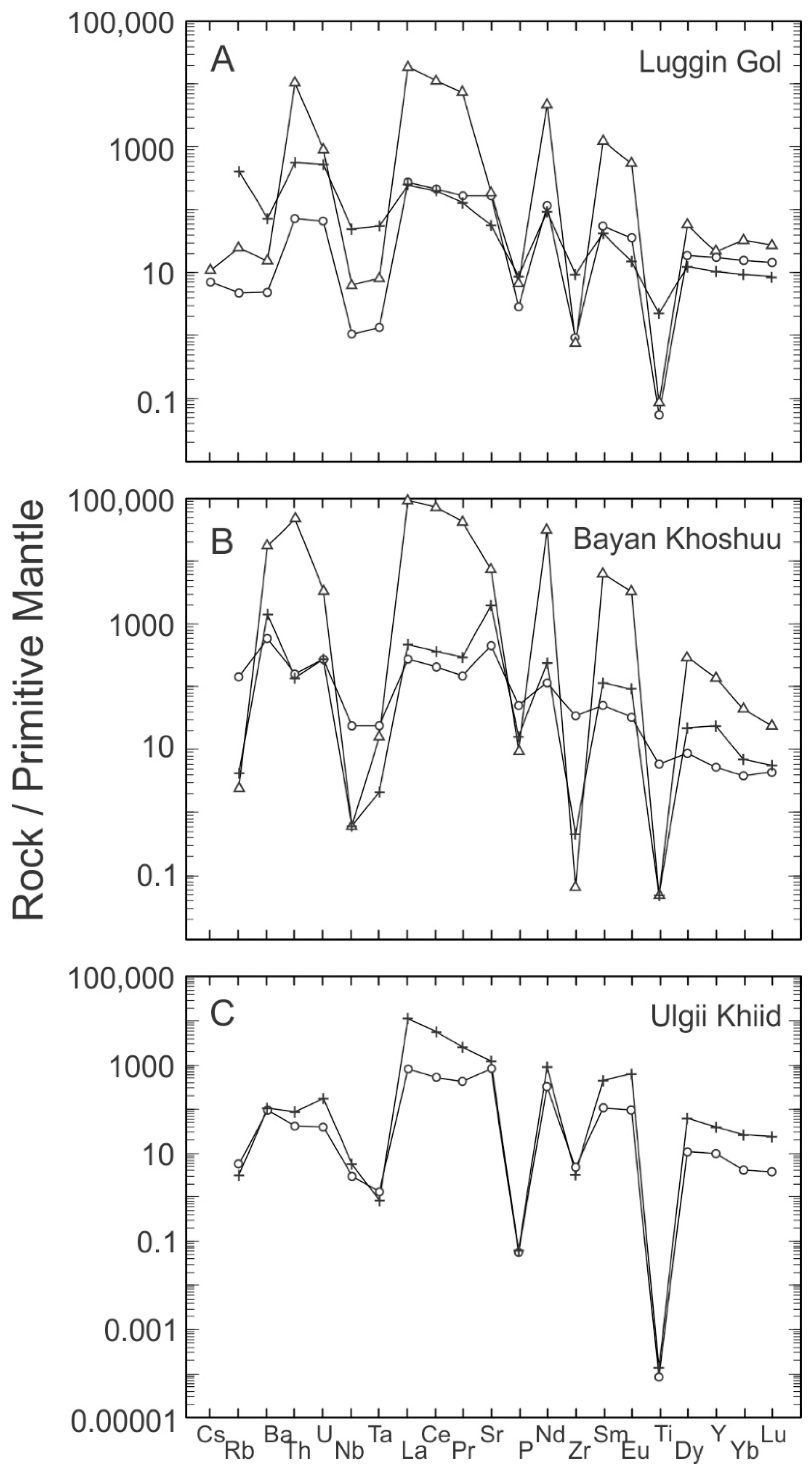
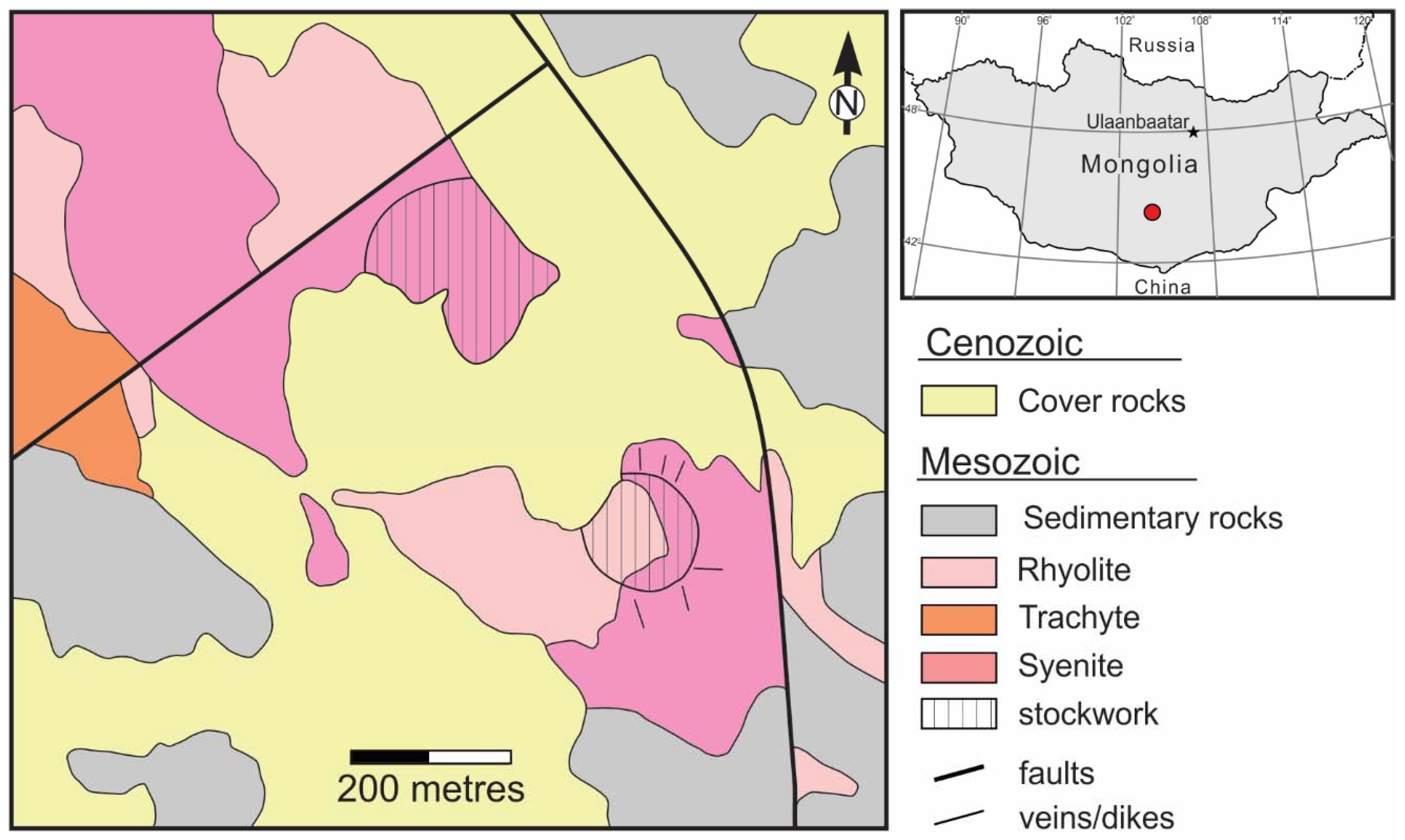
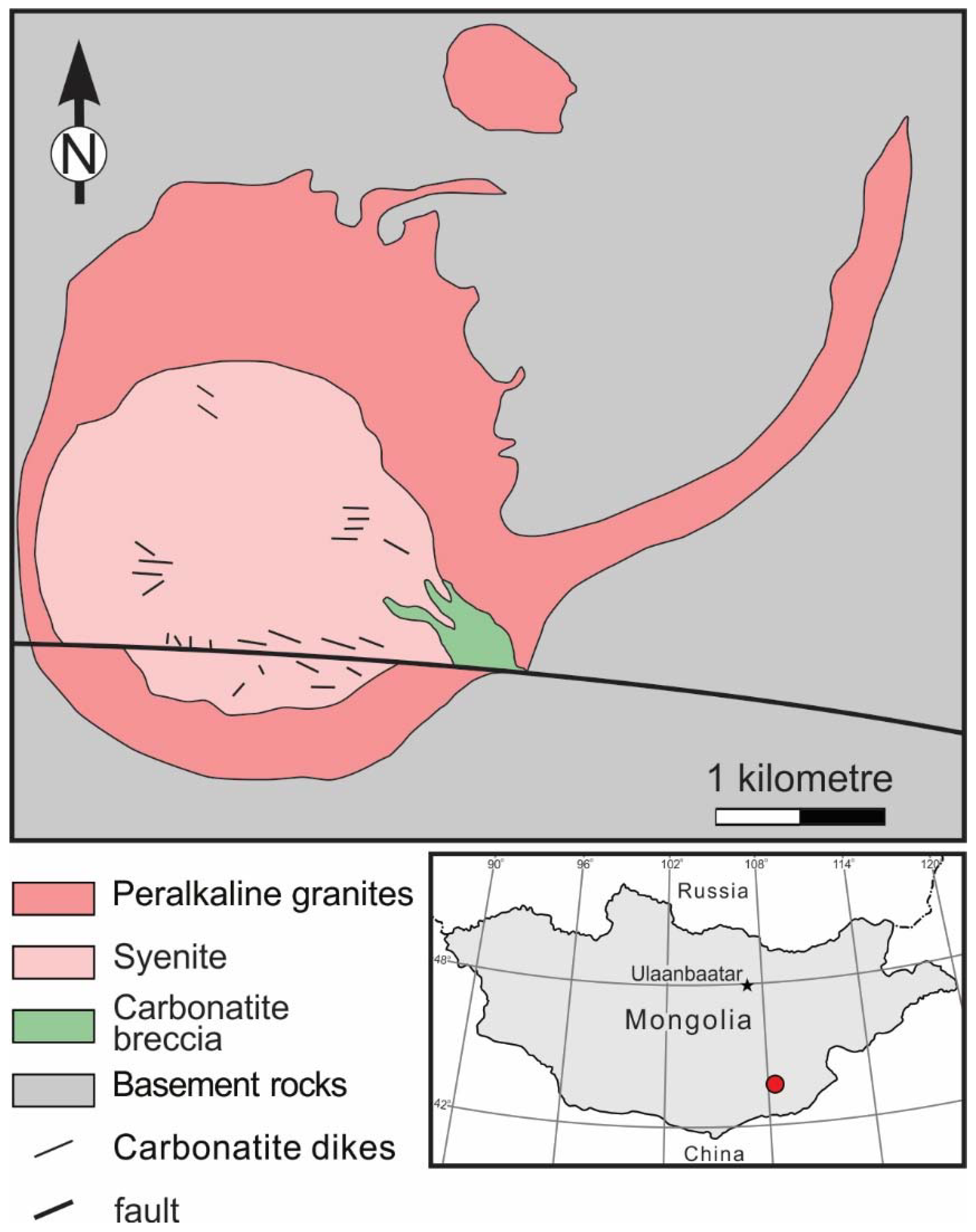
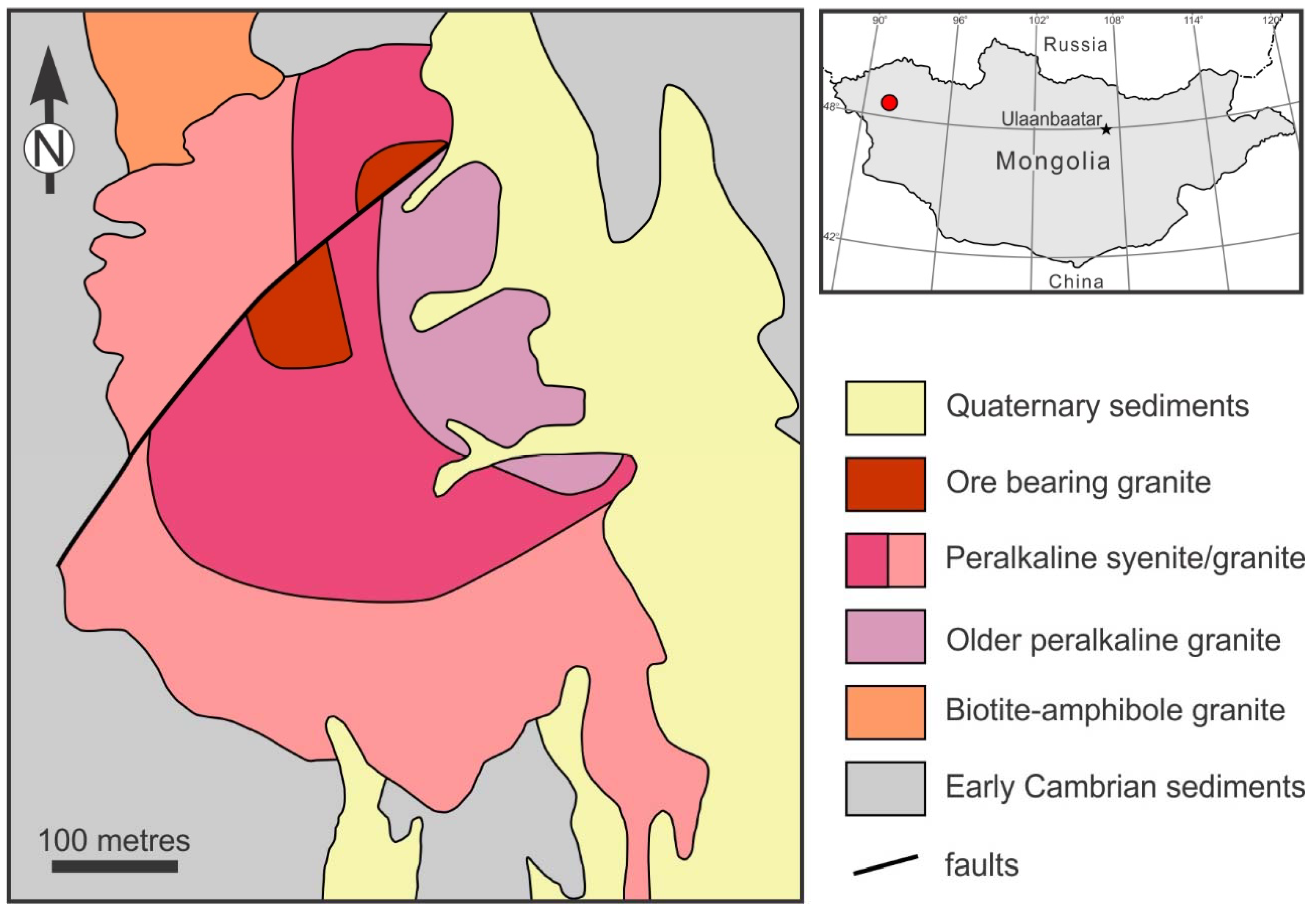

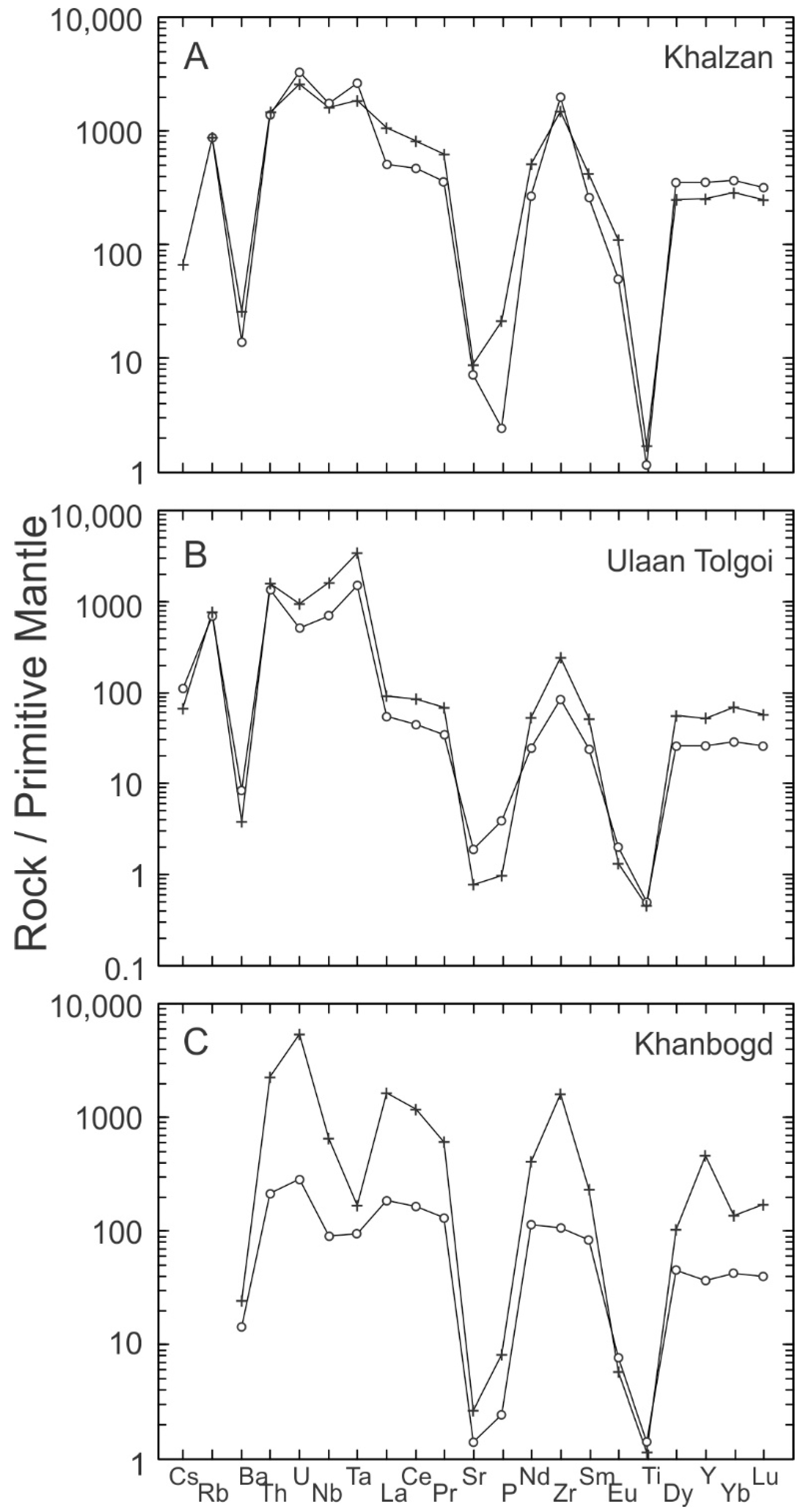
Disclaimer/Publisher’s Note: The statements, opinions and data contained in all publications are solely those of the individual author(s) and contributor(s) and not of MDPI and/or the editor(s). MDPI and/or the editor(s) disclaim responsibility for any injury to people or property resulting from any ideas, methods, instructions or products referred to in the content. |
© 2023 by the authors. Licensee MDPI, Basel, Switzerland. This article is an open access article distributed under the terms and conditions of the Creative Commons Attribution (CC BY) license (https://creativecommons.org/licenses/by/4.0/).
Share and Cite
Dostal, J.; Gerel, O. Rare Earth Element Deposits in Mongolia. Minerals 2023, 13, 129. https://doi.org/10.3390/min13010129
Dostal J, Gerel O. Rare Earth Element Deposits in Mongolia. Minerals. 2023; 13(1):129. https://doi.org/10.3390/min13010129
Chicago/Turabian StyleDostal, Jaroslav, and Ochir Gerel. 2023. "Rare Earth Element Deposits in Mongolia" Minerals 13, no. 1: 129. https://doi.org/10.3390/min13010129
APA StyleDostal, J., & Gerel, O. (2023). Rare Earth Element Deposits in Mongolia. Minerals, 13(1), 129. https://doi.org/10.3390/min13010129







